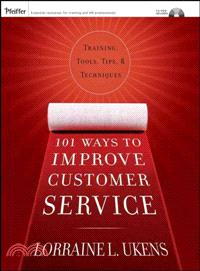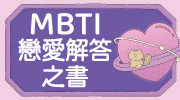101 WAYS TO IMPROVE CUSTOMER SERVICE
商品資訊
ISBN13:9780787982003
出版社:JOHN WILEY & SONS;LTD
作者:LORRAINEL. UKENS
出版日:2007/02/05
裝訂/頁數:平裝/400頁
定價
:NT$ 2608 元優惠價
:90 折 2347 元
無庫存,下單後進貨(到貨天數約30-45天)
下單可得紅利積點:70 點
商品簡介
作者簡介
目次
相關商品
商品簡介
101 Ways to Improve Customer Service provides a variety of training and development interventions that can be put to use right now with frontline service employees. Your customer service representatives directly influence the perception that customers have of your products and services and ultimately your company. It is vital that your employees develop service strategies to create a positive image, communicate effectively, and build customer rapport to support the underlying values and beliefs of your organization.
作者簡介
Lorraine L. Ukens is the owner of Team-ing with Success, a consulting and training enterprise specializing in team building and leadership development. Her wide range of business experience, spanning more than twenty-five years, is applied in designing, facilitating, and evaluating programs in a variety of human resource development areas. Ukens is the author of more than ten books including the best-selling simulation, Lost in the Amazon and her most recent collection of activities, The New Encyclopedia of Group Activities, both from Pfeiffer. She received her M.S. degree from Towson University where she taught as an adjunct faculty member from 1997 until 2005.
目次
Contents for the CD-ROM.
Introduction: Getting the Most from This Resource.
Topical Index of Interventions.
Section ONE: Awareness.
Training 1: Collection Inspection:Observation.
Training 2: Conjecture Lecture: First Impressions.
Training 3: Information, Please:Observation and Information Gathering.
Training 4: It’s a Jungle out There: Stereotyping.
Training 5: Just My Luck: Personal Perspective.
Training 6: Making Sense of It: Sensory Acuity.
Training 7: See Saw:Visual Perception.
Training 8: Stressing the Positive:Workplace Stressors.
Training 9: What Now? Perceptual Expectations.
Tool 10: On the Line: Credibility.
Tool 11: Power Up: Assertiveness.
Tip 12: Flex Your Mind:Mental Flexibility.
Tip 13: Keep It Cool: Job Pressure.
Tip 14: Stress Buster: Stress Reduction.
Technique 15: Meltdown:Dealing with Anger.
Technique 16: Plead Your Case: Influencing Change.
Section TWO: Communication.
Training 17: Blueprints for Success:Verbal Instructions.
Training 18: From Me to You: Focus on Others.
Training 19: Negative Ten-dency:Word Usage.
Training 20: Poker Face:Nonverbal Communication.
Training 21: Say What You Mean: Concise Verbal Communication.
Training 22: Seeing Is Believing: Body Language and Culture.
Training 23: Summary Judgment: Listening.
Training 24: Tongue-Tying Twisters:Word Enunciation.
Tool 25: Listen Closely: Responsive Listening.
Tool 26: Mind the Message: Communication Processes.
Tool 27: Probing Points:Questioning.
Tool 28: Sound Advice:Voice Quality.
Tip 29: Crossing the Border: International Communication.
Tip 30: E-Service: Electronic Communication.
Technique 31: Attention, Please: Keeping the Customer’s Attention.
Technique 32: Return Policy: Feedback Guidelines.
Technique 33: Six Degrees of Persuasion: Influencing Through Listening.
Section THREE: Planning.
Training 34: Color Quest: Limited Resources.
Training 35: Commercial Appeal: Product or Service Offerings.
Training 36: Flow Motion:Work Process Improvement.
Training 37: Hardware: Classifying Resources.
Training 38: Heads and Tails: Optimizing Resources.
Training 39: Last Straw: Goal Setting and Resources.
Training 40: On Target: Goal Alignment.
Training 41: View from the Top: Personal Change Management.
Tool 42: Desk Stress: Organization.
Tool 43: Pass It On:Delegation.
Tip 44: Flag It: File Management.
Tip 45: Just the Fax: Fax Information File.
Tip 46: Library Dues:Development Resources.
Tip 47: Memory Ticklers: Information Recall.
Tip 48: New Kids on the Block: Orientation.
Tip 49: To Do or Not to Do:To-Do Lists.
Technique 50: Setting the Bar: Service Standards.
Technique 51: Tackling Time Wasters:Time Management.
Section FOUR: Problem Solving.
Training 52: Comic Relief: Analyzing Problem Situations.
Training 53: Dialing Dilemma:Telephone Logic Problem.
Training 54: It’s All in How You Look at It: Problem Interpretation.
Training 55: Medical Breakthrough: Logical Problem Analysis.
Training 56: Miss Interpretation: Problem Interpretation.
Training 57: Nominally Speaking:Nominal Group Technique.
Training 58: Role It Out: Situational Role Play.
Training 59: Sensible Solutions: Alternative Solutions.
Tool 60: Breaking Barriers:Obstacles to Problem Solving.
Tool 61: Creativity Quotient: Self-Assessment.
Tip 62: A CAP-ital Idea: Creative Action Planning.
Tip 63: Feelings Check-In: Conflict Reaction Assessment.
Tip 64: Share to Be Aware: Interdepartmental Problem Solving.
Technique 65: Crash Control: Conflict Management Styles.
Technique 66: Fair Play:Win-Win Negotiation.
Technique 67: Stage Right: Creative Process.
Section FIVE: Quality.
Training 68: Getting the Word Out:Quality Components.
Training 69: Inconvenience Store: Service Strategies.
Training 70: Like It or Not: Service Analogies.
Training 71: Making the Connection: Customer Expectations.
Training 72: Overcharged and Underrated: Exceeding Expectations.
Training 73: Picture Perfect: Communicating Quality.
Training 74: RATER of the Lost Art: Customer Perception of Quality.
Training 75: Right Approach: Service Attitude.
Training 76: Service Link: Creative Analysis of Service.
Tool 77: Cream of the Crop:Quality Competencies.
Tool 78: May I Help You? Telephone Etiquette.
Tip 79: Behind the Scenes: Support Role Recognition.
Tip 80: Getting Down to Business: Customer Comment Cards.
Tip 81: Hit the Heights: Customer Service Week.
Tip 82: Knowledge Is Power:Technical Training.
Technique 83: Concession Stand: Acknowledging Customer Concerns.
Technique 84: Write On: Letters of Complaint.
Section SIX: Teamwork.
Training 85: Candy Land: Group Decision Making.
Training 86: In and Out: Internal Customers.
Training 87: Mind the Details: Individual vs.Team Performance.
Training 88: On Course: Communication, Reliability, and Trust.
Training 89: Open Account:Team Environment.
Training 90: Port of Call: Partnering Strategies.
Training 91: Seeing STARS: Group Interdependence.
Training 92: To the Letter:Time-Constrained Team Performance.
Tool 93: A Matter of Trust:Team Member Trust.
Tool 94: Team Checkup: Group Effectiveness.
Tip 95: Bank on It: Peer Recognition.
Tip 96: Get on Board: Peer Feedback.
Tip 97: Rely on Me:Team Trust.
Tip 98: Rivalry or Revelry: Constructive Competition.
Tip 99: Team Talent: Resource Directory.
Technique 100: Confront with Care:Team Conflict Management.
Technique 101: Opposition Position: Constructive Competition.
Appendix A: Internal Customer Service.
Appendix B: Call Centers.
Appendix C: Retail.
Appendix D: Sales.
About the Author.
How to Use the CD-ROM.
Introduction: Getting the Most from This Resource.
Topical Index of Interventions.
Section ONE: Awareness.
Training 1: Collection Inspection:Observation.
Training 2: Conjecture Lecture: First Impressions.
Training 3: Information, Please:Observation and Information Gathering.
Training 4: It’s a Jungle out There: Stereotyping.
Training 5: Just My Luck: Personal Perspective.
Training 6: Making Sense of It: Sensory Acuity.
Training 7: See Saw:Visual Perception.
Training 8: Stressing the Positive:Workplace Stressors.
Training 9: What Now? Perceptual Expectations.
Tool 10: On the Line: Credibility.
Tool 11: Power Up: Assertiveness.
Tip 12: Flex Your Mind:Mental Flexibility.
Tip 13: Keep It Cool: Job Pressure.
Tip 14: Stress Buster: Stress Reduction.
Technique 15: Meltdown:Dealing with Anger.
Technique 16: Plead Your Case: Influencing Change.
Section TWO: Communication.
Training 17: Blueprints for Success:Verbal Instructions.
Training 18: From Me to You: Focus on Others.
Training 19: Negative Ten-dency:Word Usage.
Training 20: Poker Face:Nonverbal Communication.
Training 21: Say What You Mean: Concise Verbal Communication.
Training 22: Seeing Is Believing: Body Language and Culture.
Training 23: Summary Judgment: Listening.
Training 24: Tongue-Tying Twisters:Word Enunciation.
Tool 25: Listen Closely: Responsive Listening.
Tool 26: Mind the Message: Communication Processes.
Tool 27: Probing Points:Questioning.
Tool 28: Sound Advice:Voice Quality.
Tip 29: Crossing the Border: International Communication.
Tip 30: E-Service: Electronic Communication.
Technique 31: Attention, Please: Keeping the Customer’s Attention.
Technique 32: Return Policy: Feedback Guidelines.
Technique 33: Six Degrees of Persuasion: Influencing Through Listening.
Section THREE: Planning.
Training 34: Color Quest: Limited Resources.
Training 35: Commercial Appeal: Product or Service Offerings.
Training 36: Flow Motion:Work Process Improvement.
Training 37: Hardware: Classifying Resources.
Training 38: Heads and Tails: Optimizing Resources.
Training 39: Last Straw: Goal Setting and Resources.
Training 40: On Target: Goal Alignment.
Training 41: View from the Top: Personal Change Management.
Tool 42: Desk Stress: Organization.
Tool 43: Pass It On:Delegation.
Tip 44: Flag It: File Management.
Tip 45: Just the Fax: Fax Information File.
Tip 46: Library Dues:Development Resources.
Tip 47: Memory Ticklers: Information Recall.
Tip 48: New Kids on the Block: Orientation.
Tip 49: To Do or Not to Do:To-Do Lists.
Technique 50: Setting the Bar: Service Standards.
Technique 51: Tackling Time Wasters:Time Management.
Section FOUR: Problem Solving.
Training 52: Comic Relief: Analyzing Problem Situations.
Training 53: Dialing Dilemma:Telephone Logic Problem.
Training 54: It’s All in How You Look at It: Problem Interpretation.
Training 55: Medical Breakthrough: Logical Problem Analysis.
Training 56: Miss Interpretation: Problem Interpretation.
Training 57: Nominally Speaking:Nominal Group Technique.
Training 58: Role It Out: Situational Role Play.
Training 59: Sensible Solutions: Alternative Solutions.
Tool 60: Breaking Barriers:Obstacles to Problem Solving.
Tool 61: Creativity Quotient: Self-Assessment.
Tip 62: A CAP-ital Idea: Creative Action Planning.
Tip 63: Feelings Check-In: Conflict Reaction Assessment.
Tip 64: Share to Be Aware: Interdepartmental Problem Solving.
Technique 65: Crash Control: Conflict Management Styles.
Technique 66: Fair Play:Win-Win Negotiation.
Technique 67: Stage Right: Creative Process.
Section FIVE: Quality.
Training 68: Getting the Word Out:Quality Components.
Training 69: Inconvenience Store: Service Strategies.
Training 70: Like It or Not: Service Analogies.
Training 71: Making the Connection: Customer Expectations.
Training 72: Overcharged and Underrated: Exceeding Expectations.
Training 73: Picture Perfect: Communicating Quality.
Training 74: RATER of the Lost Art: Customer Perception of Quality.
Training 75: Right Approach: Service Attitude.
Training 76: Service Link: Creative Analysis of Service.
Tool 77: Cream of the Crop:Quality Competencies.
Tool 78: May I Help You? Telephone Etiquette.
Tip 79: Behind the Scenes: Support Role Recognition.
Tip 80: Getting Down to Business: Customer Comment Cards.
Tip 81: Hit the Heights: Customer Service Week.
Tip 82: Knowledge Is Power:Technical Training.
Technique 83: Concession Stand: Acknowledging Customer Concerns.
Technique 84: Write On: Letters of Complaint.
Section SIX: Teamwork.
Training 85: Candy Land: Group Decision Making.
Training 86: In and Out: Internal Customers.
Training 87: Mind the Details: Individual vs.Team Performance.
Training 88: On Course: Communication, Reliability, and Trust.
Training 89: Open Account:Team Environment.
Training 90: Port of Call: Partnering Strategies.
Training 91: Seeing STARS: Group Interdependence.
Training 92: To the Letter:Time-Constrained Team Performance.
Tool 93: A Matter of Trust:Team Member Trust.
Tool 94: Team Checkup: Group Effectiveness.
Tip 95: Bank on It: Peer Recognition.
Tip 96: Get on Board: Peer Feedback.
Tip 97: Rely on Me:Team Trust.
Tip 98: Rivalry or Revelry: Constructive Competition.
Tip 99: Team Talent: Resource Directory.
Technique 100: Confront with Care:Team Conflict Management.
Technique 101: Opposition Position: Constructive Competition.
Appendix A: Internal Customer Service.
Appendix B: Call Centers.
Appendix C: Retail.
Appendix D: Sales.
About the Author.
How to Use the CD-ROM.
主題書展
更多
主題書展
更多書展今日66折
您曾經瀏覽過的商品
購物須知
外文書商品之書封,為出版社提供之樣本。實際出貨商品,以出版社所提供之現有版本為主。部份書籍,因出版社供應狀況特殊,匯率將依實際狀況做調整。
無庫存之商品,在您完成訂單程序之後,將以空運的方式為你下單調貨。為了縮短等待的時間,建議您將外文書與其他商品分開下單,以獲得最快的取貨速度,平均調貨時間為1~2個月。
為了保護您的權益,「三民網路書店」提供會員七日商品鑑賞期(收到商品為起始日)。
若要辦理退貨,請在商品鑑賞期內寄回,且商品必須是全新狀態與完整包裝(商品、附件、發票、隨貨贈品等)否則恕不接受退貨。
























